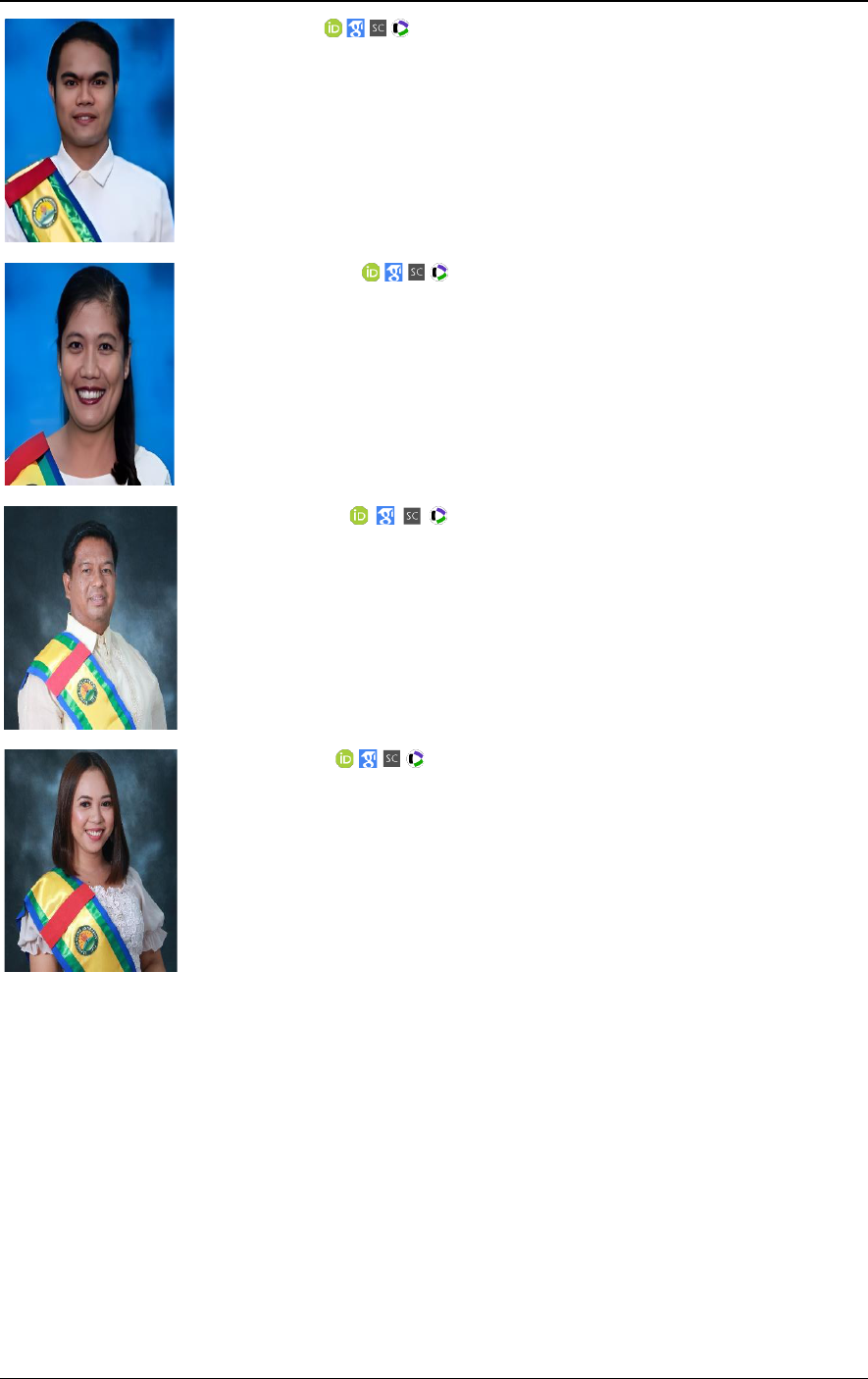
International Journal of Evaluation and Research in Education (IJERE)
Vol. 13, No. 1, February 2024, pp. 339~346
ISSN: 2252-8822, DOI: 10.11591/ijere.v12i4.25395 339
Journal homepage: http://ijere.iaescore.com
Stakeholders’ awareness and acceptance of the vision, mission,
goals, and outcomes statements of a teacher education college
Januard D. Dagdag, Noel A. Palapuz, Jane C. Caliboso, Eddie I. Peru, Regina P. Mauro
College of Education, Isabela State University, Roxas, Philippines
Article Info
ABSTRACT
Article history:
Received Sep 7, 2022
Revised Mar 13, 2023
Accepted Apr 11, 2023
This study examined the awareness and acceptance of the stakeholders of a
teacher education college in the Philippines of their university vision and
mission and the college goals, and outcomes statements (VMGOs). Of the
700 target respondents, 406 stakeholders responded to the survey transcribed
in Google Form. They were 42 school personnel, 106 parents, and 258
students; 301 females and 105 males. The five-point rating scales asked the
respondents to assess their awareness and acceptance of 16 statements
including one vision, one mission, five institutional outcomes (IO), two
college goals, and seven program outcomes (PO). The respondents as a
whole indicated they were very aware of the VMGOs and these were very
acceptable for them. However, the school personnel were consistently more
aware than the students and the parents/officials; while the parents/officials
consistently indicated the lowest awareness and acceptability scores for all
the statements. The results further revealed a significant acceptable
relationship between awareness and acceptability scores. The variables share
a variance ranging from 51% to 61% confirming that as awareness increases,
acceptance rate also increases. Various implications of these findings are
discussed.
Keywords:
Acceptability
Awareness
Isabela State University
Quality education
VMGOs
This is an open access article under the CC BY-SA license.
Corresponding Author:
Noel A. Palapuz
College of Education, Isabela State University
Rang-ayan, 3320 Roxas, Isabela, Philippines
Email: noel.a.[email protected]h
1. INTRODUCTION
Nowadays, external accrediting bodies focus on outputs as bases in judging the quality of a system
[1]. Many countries like the United States, Canada, New Zealand [2], Hong Kong [3], and the Association of
Southeast Asian Nations (ASEAN) member-states [4] adopt an educational approach called outcomes-based
education (OBE). In the Philippines, with Commission on Higher Education (CHED) memorandum 46 series
of 2012, the implementation of this education became the main thrust of all higher education institutions [5].
All institutions have changed their statements of vision, mission, goals and objectives (VMGOs) into ones
that can be translated into realities such that their students can attain them as they exit their courses.
The Isabela State University’s vision and mission and its different curricular programs’ goals and
objectives serve as the guiding principles of Roxas Campus in serving the community through instruction,
research, extension, and resource-generation. The vision, mission, goals, and objectives are the fundamental
guides for the future of the institution and its academic programs. The vision should reflect what the
university hopes to become in the future while the mission should express the broad procedures the university
would undertake to fulfill its vision. The goals of the college, on the other hand, should direct the college
toward the attainment of the university vision and long-term outcomes; and the program outcomes (PO)

ISSN: 2252-8822
Int J Eval & Res Educ, Vol. 12, No. 4, December 2023: 339-346
340
should clearly establish the significant and complex competencies educators want their students to be able to
do successfully before they can get the degree.
The university conducted the first leg of strategic development planning in 2017, and included in the
planning sessions is the revision of the vision and mission of the university. The 2019-2024 strategic
development plan, where the new university vision and mission are stipulated, had been institutionalized by
Virtue of Board of Regents (BOR) resolution No. 16, s. 2019. The vision of the university is to be a leading
research university in the ASEAN region, and its mission is to be committed to developing globally
competitive human, technological resources and services through quality instruction, innovative research,
responsive community engagement and viable resource management programs for inclusive growth and
sustainable development. The desired institutional outcomes (IO) are graduates who are communicators,
inquiry-focused and knowledgeable, competitive, collaborative and effective leaders, and lifelong learners.
The goals of the teacher education college are to: i) enhance the qualification of educators for
academic and professional development equipped with training and educational innovation as well as
research and extension; and ii) prepare and develop highly qualified education teachers and skilled
technologists through and well-rounded pre-service trainings in both academic and vocational fields for
diverse community of learners. Lastly, the PO are teachers who: i) possess wide range of theoretical and
practical skills of an effective delivery instruction; ii) can perform the necessary competencies needed in the
different learning areas in the secondary school; iii) can conduct research of instruction; iv) can undertake
actual training in community development through extension activities; v) can apply appropriate innovative
and alternative teaching approaches; vi) can practice the professional and ethical requirements of the teaching
profession; and vii) can demonstrate desirable Filipino value as a foundation for social citizenship
participation.
Since the university has a newly approved vision and mission statement (Isabela State University
strategic plan 2019), stakeholders are mandated to actively disseminate, implement, and realize what the
university wanted to become in the future. The VMGOs, which are the desires of the university, must be the
ultimate focus of the curricula and policies and they must be clear to all stakeholders most especially the
teachers and the students [6]–[10]. Moreover, research by Biggs and Tang [11] added that high competence is
only facilitated when all individuals involved in the educational arena accept and are aware of their
statements of qualities (e.g. VMGOs). Hence, the attainment of these statements largely depends on the
extent of acceptance and awareness of the stakeholders.
The stakeholders’ awareness and acceptability of the statements of the university and a college
program are very vital in the realization of the institutional drives and mandates. Research by Garcia et al.
[12] stated that this could serve a mechanism to further enhance and improve the existing practices, policies,
programs, and trainings of the institution. There were already studies that sought the stakeholders’ level of
awareness and acceptability on the organizations’ VMGOs [13]–[23]. There are also several researchers that
sought the congruence and relevance of their organizations’ VMGOs [24]–[27], as well as the extent that
these statements are being disseminated [27]–[30].
To the best of the authors’ knowledge, the stakeholders’ awareness and acceptability on the VMGOs
of the university and the teacher education program is not yet conducted locally. It is for these reasons that
this study is conceived in order to determine whether or not the different stakeholders have an acceptable
level of awareness of the vision and mission of the university and the goals and outcomes of the different
academic programs. The current study aimed to assess the stakeholders’ awareness and acceptability of the
college VMGOs statements. It further sought to compare the level of awareness and acceptability of school
personnel, parents/officials, and students and explore the relationship between awareness and acceptability of
the statements.
2. RESEARCH METHOD
Generally, the study utilized a descriptive method of research to assess for the awareness and
acceptance of the VMGOs statements. A correlational analysis was conducted to test the relationship
between awareness and acceptance. While a comparative analysis was done to compare the awareness and
acceptance scores of school personnel, parents/officials, and students.
2.1. Participants and setting
The location of the study is at Isabela State University, Rang-ayan, Roxas, Isabela, Philippines. The
target population is the stakeholders of the college of education during the school year 2020-2021. The
college offers Bachelor of Secondary Education (BSE) major in mathematics and major in Filipino. There
were three sections of freshmen students (no major), two sections of second year students majoring in
Filipino, one section of second year students majoring in mathematics, one section of third year students

Int J Eval & Res Educ ISSN: 2252-8822
Stakeholders’ awareness and acceptance of the vision, mission, goals, and … (Januard D. Dagdag)
341
majoring in Filipino, and another section of third year students majoring in mathematics. The expected
population size consists of 100 school personnel, 300 students, and 300 parents/officials. Hence, the 406
stakeholders who served as respondents in the study (42 school personnel, 106 parents, and 258 students)
represent the 58 percent of the population. Of the 406 respondents, 301 (74.1%) were females and 105
(25.9%) were males.
2.2. Instrumentation
A research instrument was developed in the form of rating scales. The levels used for awareness
were 1 if not at all aware, 2 if slightly aware, 3 if moderately aware, 4 if very aware, and 5 if extremely
aware. The levels used for acceptability were 1 if not at all acceptable, 2 if slightly acceptable, 3 if
moderately acceptable, 4 if very acceptable, and 5 if completely acceptable. The content validity of the
instrument was established first. The Cronbach reliability of the scales for awareness and acceptability were
.991 and .992, respectively. The respondents were asked to rate their awareness and acceptability of 16
statements including one vision, one mission, 5 IO, 2 college goals, and 7 PO.
2.3. Data collection
Due to limitations on personal data gathering brought by the existing protocols against COVID-19,
an electronic survey was conducted through the use of a Google Form. The research instrument was tailored
in a Google Form and the link was sent to all the target respondents through messenger group chats and
Facebook groups. We requested the students to assist their parents (guardians) in answering the survey
honestly and completely. Despite this request, however, some parents were not still able to respond to the
survey for some unidentified reasons. The researchers informed the respondents about the nature of the
current study and assured them that their responses would be kept confidential most especially from the
office of the college dean and higher school authorities. This step was done to allow the respondents to freely
indicate their real level of awareness and acceptability of the VMGOs.
2.4. Data analysis
The data were transferred to SPSS for data analysis. Frequency count and percent were utilized to
gauge the respondents’ distribution as to sex and category as stakeholder. Mean was used to determine their
average awareness scores and acceptability of the VMGOs. The mean scores were described according to the
guidelines as presented in Table 1.
Standard deviations were also computed to gauge how consistent their responses are regarding their
awareness and the acceptability of the VMGOs. Pearson correlation was used to explore the relationship
between the awareness and acceptability scores. While one-way between-groups analysis of variance was
conducted to compare the awareness and acceptability scores indicated by school personnel, parents/officials,
and students.
Table 1. Mean score guidelines
Scale
Mean
Awareness
Acceptability
1
0.50–1.49
Not at all aware
Not at all acceptable
2
1.50–2.49
Slightly aware
Slightly acceptable
3
2.50–3.49
Moderately aware
Moderately acceptable
4
3.50–4.49
Very aware
Very acceptable
5
4.50–5.00
Extremely aware
Completely acceptable
3. RESULTS
In the context of institutional development and strategic planning, stakeholders’ awareness and
acceptance of an educational institution’s VMGOs statements play a pivotal role. These statements define the
institution’s core principles, objectives, and future direction. Understanding stakeholders’ perspectives
regarding these statements is essential for effective strategic decision-making and alignment of efforts. This
analysis delves into the findings presented in Table 2, which shows that the stakeholders indicated they are
very aware of the VMGOs statements. Similarly, they rated the VMGOs statements as very acceptable. Such
a robust awareness and acceptance of the VMGOs statements can lay a solid foundation for effective
strategic planning, informed decision-making, and collaborative efforts within the academic community.
Table 3 shows the comparison of the awareness scores among the categories of stakeholders. The
results showed 99% confidence level in claiming that the school personnel were more aware than the
parents/officials and students but the students were more aware than the parents/officials. Thereby, the
parents/officials were the least aware.

ISSN: 2252-8822
Int J Eval & Res Educ, Vol. 12, No. 4, December 2023: 339-346
342
Table 2. Stakeholders’ level of awareness and acceptability of the VMGOs
Statements
Awareness
Acceptability
M
SD
Description
M
SD
Description
Vision
3.92
1.18
Very aware
4.03
1.09
Highly accepted
Mission
3.91
1.16
Very aware
4.03
1.08
Highly accepted
IO 1
3.73
1.14
Very aware
3.94
1.07
Highly accepted
IO 2
3.69
1.13
Very aware
3.91
1.10
Highly accepted
IO 3
3.77
1.13
Very aware
3.89
1.09
Highly accepted
IO 4
3.73
1.14
Very aware
3.89
1.06
Highly accepted
IO 5
3.86
1.13
Very aware
3.92
1.10
Highly accepted
College goal 1
3.80
1.14
Very aware
3.90
1.11
Highly accepted
College goal 2
3.83
1.13
Very aware
3.92
1.07
Highly accepted
PO 1
3.73
1.16
Very aware
3.87
1.08
Highly accepted
PO 2
3.75
1.13
Very aware
3.88
1.10
Highly accepted
PO 3
3.77
1.15
Very aware
3.82
1.11
Highly accepted
PO 4
3.75
1.16
Very aware
3.86
1.11
Highly accepted
PO 5
3.79
1.16
Very aware
3.92
1.09
Highly accepted
PO 6
3.80
1.15
Very aware
3.90
1.11
Highly accepted
PO 7
3.79
1.15
Very aware
3.93
1.11
Highly accepted
Table 3. Comparison of stakeholders’ awareness of the VMGOs
Quality statements
School personnel
Parents/officials
Students
F (2, 403)
M
SD
M
SD
M
SD
Vision
4.70
a
.55
3.01
c
1.28
4.17
b
.99
58.74
**
Mission
4.60a
.70
3.07
c
1.24
4.15
b
.99
50.50
**
IO 1
4.48
a
.71
2.95
c
1.23
3.93
b
.99
45.87
**
IO 2
4.51
a
.67
3.00
c
1.24
3.85
b
1.00
38.58
**
IO 3
4.63
a
.66
3.11
c
1.25
3.91
b
.99
37.65
**
IO 4
4.48
a
.77
3.00
c
1.22
3.92
b
1.00
41.08
**
IO 5
4.60
a
.70
3.16
c
1.27
4.03
b
.99
37.08
**
College goal 1
4.58
a
.63
3.04
c
1.25
3.99
b
.99
43.88
**
College goal 2
4.63
a
.62
3.12
c
1.24
4.01
b
.99
41.19
**
PO 1
4.58
a
.66
3.05
c
1.27
3.88
b
1.03
36.79
**
PO 2
4.60
a
.62
3.09
c
1.27
3.88
b
.98
37.36
**
PO 3
4.65
a
.61
3.10
c
1.25
3.91
b
1.03
37.66
**
PO 4
4.56
a
.74
3.11
c
1.31
3.89
b
1.01
32.32
**
PO 5
4.63
a
.62
3.12
c
1.28
3.93
b
1.03
35.76
**
PO 6
4.65
a
.61
3.12
c
1.28
3.95
b
1.01
38.00
**
PO 7
4.60
a
.66
3.14
c
1.32
3.93
b
1.00
33.40
**
Note. ** means significant at .01 level
As presented in Table 4, the school personnel consistently registered the highest level of acceptance
of the VMGOs. The students reported a greater level of acceptance as compared to the parents/officials.
Thereby, the parents/officials were consistently the least accepting group. As shown in Table 5, there was a
consistent significant acceptable relationship between awareness and acceptability across all the VMGOs
statements. These constructs share a variance ranging from 51% to 61%.
Table 4. Comparison of stakeholders’ acceptability of the VMGOs
Quality statements
School personnel
Parents/officials
Students
F (2, 403)
M
SD
M
SD
M
SD
Vision
4.53
a
.71
3.49
c
1.26
4.18
b
.97
21.78
**
Mission
4.60
a
.66
3.50
c
1.18
4.15
b
1.00
22.46
**
IO 1
4.56
a
.70
3.53
c
1.18
4.01
b
1.01
16.31
**
IO 2
4.60
a
.62
3.46
c
1.23
3.98
b
1.02
19.11
**
IO 3
4.65
a
.61
3.45
c
1.23
3.95
b
1.01
20.56
**
IO 4
4.60
a
.62
3.44
c
1.18
3.96
b
.99
20.82
**
IO 5
4.58
a
.66
3.53
c
1.22
3.98
b
1.05
15.37
**
College goal 1
4.56
a
.63
3.47
c
1.23
3.98
b
1.05
16.86
**
College goal 2
4.60
a
.62
3.54
c
1.19
3.97
b
1.01
16.51
**
PO 1
4.60
a
.66
3.48
c
1.16
3.92
b
1.03
18.02
**
PO 2
4.60
a
.62
3.46
c
1.18
3.93
b
1.06
18.10
**
PO 3
4.65
a
.61
3.39
c
1.22
3.87
b
1.04
21.69
**
PO 4
4.58
a
.70
3.47
c
1.23
3.90
b
1.05
16.43
**
PO 5
4.58
a
.66
3.55
c
1.25
3.98
b
1.02
14.87
**
PO 6
4.63
a
.62
3.54
c
1.21
3.93
b
1.06
15.67
**
PO 7
4.65
a
.65
3.54
c
1.21
3.98
b
1.05
16.93
**
Note. ** means significant at .01 level

Int J Eval & Res Educ ISSN: 2252-8822
Stakeholders’ awareness and acceptance of the vision, mission, goals, and … (Januard D. Dagdag)
343
Table 5. Relationship between awareness and acceptability of VMGOs
Statements
Awareness
Acceptability
R
M
SD
M
SD
Vision
3.92
1.18
4.03
1.09
.783
**
Mission
3.91
1.16
4.03
1.08
.777
**
IO 1
3.73
1.14
3.94
1.07
.731
**
IO 2
3.69
1.13
3.91
1.10
.760
**
IO 3
3.77
1.13
3.89
1.09
.779
**
IO 4
3.73
1.14
3.89
1.06
.745
**
IO 5
3.86
1.13
3.92
1.10
.775
**
College goal 1
3.80
1.14
3.90
1.11
.722
**
College goal 2
3.83
1.13
3.92
1.07
.715
**
PO 1
3.73
1.16
3.87
1.08
.732
**
PO 2
3.75
1.13
3.88
1.10
.746
**
PO 3
3.77
1.15
3.82
1.11
.761
**
PO 4
3.75
1.16
3.86
1.11
.740
**
PO 5
3.79
1.16
3.92
1.09
.724
**
PO 6
3.80
1.15
3.90
1.11
.731
**
PO 7
3.79
1.15
3.93
1.11
.724
**
Note. ** means significant at .01 level
4. DISCUSSION
This research explores the stakeholders’ awareness and acceptance of the VMGOs of a higher
education institution. The stakeholders, as a whole, indicated a high awareness and acceptance of the
VMGOs. Several studies also underscore that stakeholders are aware and do accept their university’s
VMGOs [1], [12], [13], [28], [31]–[35]. This finding implies that stakeholders have extensive information
about the VMGO of the university. In the current study, this is a positive sign for the college as it indicates
that the stakeholders understand the purpose and objectives of the college. This could lead to higher levels of
support for the college and its initiatives, which can ultimately contribute to its success.
The three groups of stakeholders, however, significantly differed in their level of awareness and
acceptance. The school personnel specified the highest level of awareness and acceptance [12], [29], [36],
[37], while the parents/officials had the lowest [14], [21]. The parents/officials indicated that they were only
moderately aware of the VMGOs and they found the vision, some IO, goals, and PO moderately acceptable.
This indicates that the college has been more successful in communicating its goals and objectives to the
school personnel. It could also suggest that school personnel have a greater level of engagement with the
program and its initiatives. On the other hand, the lower level of awareness and acceptance among students
and parents/officials could indicate a need for the program to improve its outreach and communication
strategies to these groups. Especially, the finding that the parents/officials were the least aware and accepting
of the VMGOs suggests that there may be a disconnection between the program and this group of
stakeholders. This could result in a lack of support and resources from this group, which could negatively
impact the program's success.
Moreover, the stakeholders’ awareness and acceptance of the VMGOs were significantly and
positively associated [32], [38]. These two variables share an adequate amount of variance ranging from 51%
to 61%. This signifies that the more aware the stakeholders are about the VMGOs, the more likely they will
accept it. Research by Escolano [36] on the other hand, claimed that there is no significant relationship
between the two, as she argued that stakeholders may not fully aware of the VMGO but they truly accept it.
The current findings have important implications for the program in terms of how it communicates
and promotes its VMGOs. It may be necessary to improve the college’s communication and outreach efforts
to parents/officials, who were found to be the least aware and accepting of the VMGOs. This could involve
using different communication channels, such as social media, newsletters, or parent/student forums, to
provide information about the college’s VMGOs and to engage with these groups. It may be beneficial to
increase engagement with the school personnel, who were found to be the most aware and accepting of the
VMGOs. This could involve engaging school personnel in program initiatives and events, or providing
opportunities for them to provide feedback and input into the college’s VMGOs. Additionally, the college
should evaluate its current communication and outreach strategies to determine their effectiveness in raising
awareness and acceptance of the VMGOs among all stakeholders. Based on this evaluation, the program may
need to make changes to its strategies in order to improve communication and engagement with students,
parents/officials, and other stakeholders.
The university should intensify widest dissemination of its VMGOs in a form of print such as
tarpaulin, pamphlets, flyers, and leaflets. With the advent of advance technology, the university should also
consider uploading videos and movie clips in various social media. Conducting stakeholders’ meeting that
will regularly orient them with the VMGOs of the university may also be taken into consideration.

ISSN: 2252-8822
Int J Eval & Res Educ, Vol. 12, No. 4, December 2023: 339-346
344
Mandatory posting of VMGO in all strategic places such as adopted barangays, linkages, extension partners,
and others. Stakeholders should also be informed that the university programs, activities, and undertakings
are aligned and in support to its VMGOs. Furthermore, monitoring of stakeholders’ awareness and
acceptance of the VMGO should be done periodically. This could involve conducting surveys, focus groups,
or other forms of engagement to gather feedback and ensure that the college is meeting the needs and
expectations of all stakeholders.
5. CONCLUSION
The study highlights that the stakeholders of a teacher education college have different levels of
awareness and acceptance of the VMGOs, i.e., the school personnel are the most aware and accepting,
followed by the students, while the parents/officials are the least aware and accepting. The awareness and
acceptance of these stakeholders are directly related. Therefore, the college has to regularly monitor the
stakeholders’ awareness and acceptance of the VMGO, use clear and effective communication in raising
stakeholders’ awareness and acceptance of VMGOs, focus on increasing awareness as a means of increasing
acceptance, encourage stakeholders’ engagement, and continuously evaluate and adjust its communication
strategies. Further, future research may consider focusing on identifying the factors that contribute to the low
stakeholders’ acceptance and awareness of VMGOs.
ACKNOWLEDGEMENTS
The authors wish to extend their heartfelt gratitude to Isabela State University for funding the study.
REFERENCES
[1] R. C. Castillo, “Awareness, acceptance and perception of Batangas State University stakeholders towards its vision, mission,
goals and objectives,” International Journal of Sciences: Basic and Applied Research, vol. 14, no. 1, pp. 546–563, 2014.
[2] S. P. T. Malan, “The ‘new paradigm’ of outcomes-based education in perspective,” Journal of Consumer Sciences, vol. 28, no. 1,
pp. 22–28, Mar. 2010, doi: 10.4314/jfecs.v28i1.52788.
[3] I. L. An, “Impact of outcome-based education instruction to accountancy students in an Asian University,” Asia Pacific Journal
of Education, Arts and Sciences, vol. 1, no. 5, pp. 48–52, 2014.
[4] J. S. Hilario, “Using outcomes-based education (OBE) in the teaching and learning of community and public health with related
learning experience,” Asian Journal of Educational Research, vol. 3, no. 3, pp. 46–56, 2015.
[5] J. L. Espiritu and K. Budhrani, “Implementing an outcome-based education (OBE) framework in the teaching of industrial
psychology,” in De La Salle University Research Congress, 2015, pp. 1–8.
[6] J. D. Dagdag, “Organizational structure and procedure barriers to obedizing Philippine higher education: implications to policies
and practice,” Journal Of Research, Policy & Practice of Teachers & Teacher Education, vol. 10, no. 1, pp. 27–44, May 2020,
doi: 10.37134/jrpptte.vol10.1.3.2020.
[7] J. D. Dagdag, “Mathematics educators’ perspectives on outcome-based education: alignment with the learning paradigm of
tertiary education in the Philippines,” Journal of Thai Interdisciplinary Research, vol. 14, no. 3, pp. 1–7, 2019.
[8] J. D. Dagdag and R. S. Cardona, “Perspectives and practices on outcomes-based assessment (OBA) among college mathematics
educators in Northeastern Luzon Philippines,” Asia Pacific Journal of Multidisciplinary Research, vol. 6, no. 2, pp. 18–25, 2018.
[9] W. G. Spady and K. J. Marshall, “Beyond traditional outcome-based education,” Educational Leadership, vol. 49, no. 2, pp. 67–
72, 1991.
[10] W. G. Spady and A. Schlebusch, Curriculum 2005: a guide for parents. Cape Town: Renaissance, 1999.
[11] J. Biggs and C. Tang, “Outcomes-based teaching and learning (OBTL). What is it, why is it, how do we make it work?” pp. 1–8,
2007.
[12] S. S. Garcia, D. V. Rogayan, and K. L. M. Gagasa, “Stakeholders’ awareness and acceptability of university’s vision and mission,
and teacher education program goals and objectives in a state institution in Central Luzon, Philippines,” International Journal of
Multidisciplinary: Applied Business and Education Research, vol. 2, no. 1, pp. 17–23, Jan. 2021, doi: 10.11594/ijmaber.02.01.03.
[13] A. C. Pelicano and L. D. Lacaba, “Awareness and acceptability of the vision, mission, goals and objectives of Eastern Samar
State University,” International Journal of Innovation and Research in Educational Sciences, vol. 3, no. 6, pp. 432–435, 2016.
[14] J. A. Constantino, M. H. Sison, E. C. Gabriel, and M. T. C. Vega, “Perception, awareness, acceptance and understanding of
NEUST-SIC community towards its vision, mission, goals and objectives,” International Journal of Advanced Engineering,
Management and Science, vol. 6, no. 7, pp. 335–345, 2020, doi: 10.22161/ijaems.67.6.
[15] D. C. Bueno, “Evaluating the institution’s philosophy and objectives towards continuous improvement,” CC The Journal: A
Multidisciplinary Research Review, vol. 14, pp. 1–7, 2019.
[16] J. V. Oboza, “Awareness, acceptance, and perception of Pangasinan State University’s stakeholders towards its vision, mission,
goals, and objectives,” Southeast Asian Journal of Science and Technology, vol. 2, no. 1, pp. 59–65, 2017.
[17] S. S. Poliden and L. A. Bela-o, “Articulating the university’s vision and mission, CAS goals and program objectives,”
International Journal of Multidisciplinary Thought, vol. 7, no. 3, pp. 513–518, 2018.
[18] M. C. D. Segismundo, “Stakeholders’ awareness and acceptance of graduate programs’ vision, mission, goals, and objectives, SY
2017-2018,” International Journal of Advanced Research, vol. 5, no. 11, pp. 948–953, Nov. 2017, doi: 10.21474/IJAR01/5853.
[19] M. T. Siniguian, “Acceptability and comprehensiveness of Cagayan State University vision, mission, college goals and bachelor
of public administration program objectives,” International Journal of Advanced Research in Management and Social Sciences,
vol. 7, no. 11, pp. 30–38, 2018.

Int J Eval & Res Educ ISSN: 2252-8822
Stakeholders’ awareness and acceptance of the vision, mission, goals, and … (Januard D. Dagdag)
345
[20] H. M. S. Cascolan and M. J. A. B. Venture, “Awareness and acceptability of the Pangasinan State University vision, mission,
campus goals and the program objectives,” Journal of Education, Management and Social Sciences, vol. 2, no. 1, pp. 73–77,
2018.
[21] B. M. Nozaleda, “Awareness, acceptance, and understanding of Cagayan State University stakeholders towards its vision,
mission, goals, and objectives,” International Journal of Advanced Research in Management and Social Sciences, vol. 8, no. 6,
pp. 313–326, 2019.
[22] C. F. C. Dico et al., “Level of awareness, acceptability and timeliness of vision and mission of the Leyte Normal University,
goals of the college of arts and sciences and objectives of the social work department.” pp. 1–10, 2019.
[23] A. A. Villanca, B. S. Binayao, M. Z. D. Caterial, and V. C. Ablanque, “Assessing the vision, mission, goals and objectives of a
state university in Southern Philippines,” International Journal of Innovative Science and Research Technology, vol. 5, no. 10,
pp. 189–194, 2020.
[24] S. S. Bentor, M. P. S. Bentor, and T. C. S. Bentor, “Awareness, acceptability, and relevance of the vision, mission, goals, and
objectives of the programs of Naval State University Graduate School,” International Journal of Sciences: Basic and Applied
Research, vol. 32, no. 1, pp. 181–206, 2017.
[25] D. H. R. Reusia, D. J. V. Rogayan, and K. P. Andres, “Science education graduates of a state university from 2008-2018: a tracer
study,” The Normal Lights, vol. 14, no. 1, pp. 56–79, Jun. 2020, doi: 10.56278/tnl.v14i1.1496.
[26] D. A. Tan and T. H. Borres, “Awareness, acceptability, consistency and clarity of the vision, mission, goals and objectives of
Central Mindanao University and its congruence to outcomes-based instruction: a preliminary result,” Science International,
vol. 32, no. 1, pp. 93–98, 2020.
[27] I. E. Balcorta et al., “Awareness, participation, acceptability, relevance and dissemination of an institution’s selected indicators,”
IAR Journal of Humanities and Social Science, vol. 2, no. 1, pp. 1–5, 2021, doi: 10.47310/jiarjhss.v02i01.001.
[28] W. B. Gallinero and V. S. Otig, “Extent of dissemination, awareness, and acceptability of the revised LDCU vision, mission, and
CAS objectives among students and faculty,” Liceo Journal of Higher Education Research, vol. 12, no. 1, pp. 158–177, Jun.
2017, doi: 10.7828/ljher.v12i1.968.
[29] M. L. Laurente, “The stakeholders’ awareness and acceptability of the Leyte Normal University’s vision, mission, goal and
objectives,” International Journal for Innovation Education and Research, vol. 7, no. 4, pp. 108–117, Apr. 2019, doi:
10.31686/ijier.vol7.iss4.1392.
[30] M. D. C. Rañeses, “Bicol University College of nursing vision, mission, goal, and objectives: awareness, dissemination, and
attainment,” Bicol University Research and Development Journal, vol. 21, no. 2, pp. 28–36, 2020, doi:
10.47789/burdj.mbtcbbgs.20182102.5.
[31] M. D. Salom and Z. T. Florendo, “Awareness, acceptability, and relevance of the vision, mission, goals, and objectives of the
BSEMT program,” E-International Scientific Research Journal, vol. 5, no. 1, pp. 236–246, 2013.
[32] K. Joy, T. Compelio, L. C. Caranto, J. Jose, and T. David, “Awareness, understanding, and acceptance of student nurses of the
vision, mission, goals and objectives of Benguet State University,” International Journal of Nursing Science, vol. 5, no. 1,
pp. 20–27, 2015, doi: 10.5923/j.nursing.20150501.03.
[33] J. Castro, C. A. Lombrio, and V. N. Egargo, “Awareness and acceptance of ESSU Guiuan’s vision, mission, goals, and objectives
across the stakeholders,” SSRN Electronic Journal, pp. 1–15, 2017, doi: 10.2139/ssrn.3056077.
[34] M. G. Palangdao, J. de la Cruz, and M. Alagao, “Awareness, acceptability and perception of the students, faculty and staff
towards the VMGO of the departments of agriculture and teacher education,” Abra State Institute of Sciences and Technology
Research Journal, vol. 7, no. 1, pp. 98–122, 2009.
[35] J. N. Estrada, “Awareness and acceptability of the vision, mission and institutional goals of Pangasinan State University and AB
Economics program objectives,” Southeast Asian Journal of Science and Technology, vol. 3, no. 1, pp. 21–35, 2018.
[36] E. Escolano, “Awareness and acceptability on the institution’s vision, mission, goals and quality policy in one state college in the
Philippines,” Journal of Education, Management and Development Studies, vol. 1, no. 2, pp. 10–24, Sep. 2021, doi:
10.52631/jemds.v1i2.28.
[37] M. J. de Guzman, K. L. Estira, N. E. Arquillano, and R. J. M. Ventayen, “Acceptability and awareness of vision and mission of
the university, institutional objective and program objective of BS business administration,” Asian Journal of Business and
Technology, vol. 1, no. 1, pp. 14–17, 2018.
[38] R. G. Belo-Delariarte, R. M. F. Oducado, and W. D. Gorriceta, “Awareness and acceptability of the WVSU college of nursing’s
vision, mission, goals and program outcomes of the master of arts in nursing,” WVSU Journal of Nursing Research, vol. 10, no. 1,
pp. 47–55, 2017, doi: 10.13140/rg.2.2.14522.24006/2.
BIOGRAPHIES OF AUTHORS
Januard D. Dagdag is an esteemed Mathematics Teacher Educator at Isabela
State University-Roxas. He is an Associate Member of the National Research Council of the
Philippines. His extensive research covers areas including outcome-based education,
curriculum evaluation, scale development, self-efficacy, and licensure examination. He can be
contacted at email: [email protected].

ISSN: 2252-8822
Int J Eval & Res Educ, Vol. 12, No. 4, December 2023: 339-346
346
Noel A. Palapuz is a Master of Arts in Education major in Mathematics graduate
at Our Lady of Pillar College Cauayan. He is currently a mathematics instructor at Isabela
State University. He has already presented research studies in local and international level and
has attended research conferences and seminars. He has research article published in
International Journal of Evaluation and Research in Education (IJERE). He can be contacted
at email: [email protected].
Dr. Jane C. Caliboso obtained her Bachelor of Science in Secondary Education
major in English, Master of Science in Teaching with specialization in English at Saint Paul
University Philippines, and Doctor of Education major in Language Education English. She is
a full- time faculty of Isabela State University Roxas Campus. She has also research articles
published in an international research journal. She can be contacted at email:
Dr. Eddie I. Peru is a member of International Association of Scholarly
Publisher, Editor & Reviewers, Inc. (IASPER). He obtained Bachelor of Science in
Information Technology at Saint Paul University, Master in Information Technology at
University of La Sallete, Santiago City and Doctor of Philosophy in Our Lady of Pillar
College, Cauayan City, Isabela. He is a full-time faculty at Isabela State University Cauayan
Campus. He already presented research studies and attended local and international research
conferences and seminars. He can be contacted at email: [email protected].
Regina P. Mauro is a graduate of Bachelor of Science in Agriculture major in
Soil Science at Isabela State University Echague Campus. At present, she is pursuing her
master’s degree in Soil Science at Benguet State University, La Trinidad, Benguet. She is a
full-time faculty at Isabela State University Roxas Campus. She already presented research
studies and attended local and international research conferences and seminars. She can be
contacted at email: [email protected].
